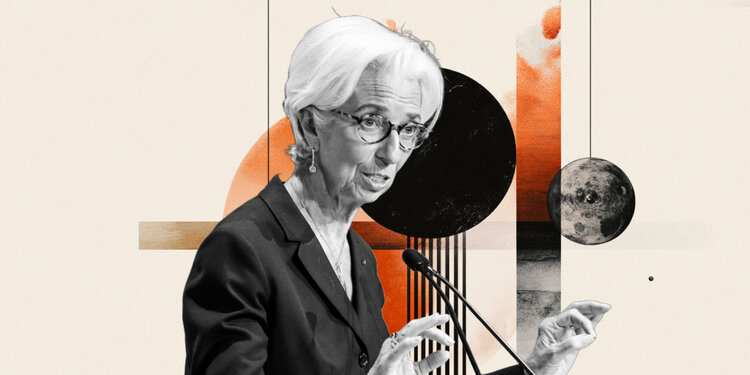
Christine Lagarde, President of the European Central Bank (ECB), has detailed the ECB’s decision to maintain the current interest rates after their latest policy meeting in July, addressing various inquiries during a press conference.
Highlights from the ECB Press Conference
“Survey data indicate a generally modest expansion.”
“Increased tariffs and a stronger Euro could challenge investment by firms.”
“A robust labor market, rising real incomes, and strong private sector balance sheets are supporting consumption.”
“Investments in defense and infrastructure are expected to drive growth.”
“Core inflation indicators suggest that inflation should stabilize around the target level.”
“Long-term inflation expectations are consistently around 2%.”
“Economic growth risks are still skewed to the downside.”
“The inflation outlook for the Euro Area is unusually uncertain.”
“We do not target exchange rates, but we do monitor them.”
“Wage trends are moving in the right direction.”
“Unit profits are helping to offset wage increases.”
“We are confident that the inflationary shock has passed.”
“There are always a few governors very concerned about not meeting our targets.”
“Retaliation is a possibility, not a certainty.”
“The inflationary or deflationary impact of tariffs is still unclear.”
“Tariffs are likely to cause bottlenecks.”
“It is a consensus that we must respond to data as it arrives.”
“Resolving trade tensions quickly would reduce some uncertainties.”
“There is ample liquidity in the banking system.”
This section was initially published at 12:15 GMT to summarize the ECB’s monetary policy announcements and the immediate market reactions.
The European Central Bank (ECB) announced on Thursday that it has decided to keep key rates unchanged following their July policy meeting. The rates for the main refinancing operations, the marginal lending facility, and the deposit facility remain at 2.15%, 2.4%, and 2% respectively.
Key Insights from the ECB Policy Statement
“The latest information aligns broadly with the ECB’s prior assessment of the inflation outlook.”
“Domestic price pressures are easing, with wage growth slowing.”
“Reflecting past ECB rate cuts, the economy has remained resilient overall amidst a challenging global scenario.”
“However, the environment is exceptionally uncertain, especially due to ongoing trade disputes.”
“Monetary policy will continue to be determined on a data-dependent, meeting-by-meeting basis.”
“Interest rate decisions will hinge on the inflation outlook and surrounding risks, considering new economic and financial data, inflation dynamics, and the effectiveness of monetary policy transmission.”
“The ECB has not committed to a specific future rate path.”
Market Reactions to ECB Policy Decisions
The EUR/USD pair showed no immediate reaction to the ECB policy announcements and was last recorded trading at 1.1755, marking a 0.15% decline for the day.
Euro PRICE This week
The table below shows the percentage change of Euro (EUR) against listed major currencies this week. Euro was the strongest against the US Dollar.
| USD | EUR | GBP | JPY | CAD | AUD | NZD | CHF | |
|---|---|---|---|---|---|---|---|---|
| USD | -1.06% | -0.99% | -1.01% | -0.76% | -1.53% | -1.34% | -0.87% | |
| EUR | 1.06% | 0.15% | 0.07% | 0.30% | -0.52% | -0.46% | 0.15% | |
| GBP | 0.99% | -0.15% | -0.30% | 0.18% | -0.63% | -0.40% | 0.20% | |
| JPY | 1.01% | -0.07% | 0.30% | 0.25% | -0.49% | -0.38% | 0.31% | |
| CAD | 0.76% | -0.30% | -0.18% | -0.25% | -0.71% | -0.58% | -0.16% | |
| AUD | 1.53% | 0.52% | 0.63% | 0.49% | 0.71% | 0.13% | 0.81% | |
| NZD | 1.34% | 0.46% | 0.40% | 0.38% | 0.58% | -0.13% | 0.59% | |
| CHF | 0.87% | -0.15% | -0.20% | -0.31% | 0.16% | -0.81% | -0.59% |
This heat map displays the percentage changes of major currencies against each other. The base currency is selected from the left column, and the quote currency from the top row. For instance, selecting the Euro from the left and moving horizontally to the US Dollar shows the percentage change in the box, representing EUR (base)/USD (quote).
This section below was initially published as a preview of the European Central Bank’s (ECB) monetary policy announcements at 05:00 GMT.
- The European Central Bank is anticipated to maintain key rates unchanged for the first time in over a year this Thursday.
- The Eurozone’s inflation rate has achieved the ECB’s 2% target, amidst ongoing uncertainty over the US-EU trade deal.
- The EUR/USD pair may see significant volatility following the ECB policy announcements.
The ECB is poised to keep its key interest rates steady after its July policy meeting, following a series of rate cuts in its last seven meetings. The announcement is scheduled for Thursday at 12:15 GMT, followed by President Christine Lagarde’s press conference at 12:45 GMT.
The ECB policy announcements are expected to significantly influence the EUR/USD performance, as the Euro is likely to experience substantial volatility following the decision and during President Lagarde’s press conference.
Expectations from the ECB Interest Rate Decision
With the market anticipating no change in rates, attention will focus on the ECB’s policy statement for any indications that the central bank might resume its rate-cutting cycle later this year amid concerns over potential impacts of higher US tariffs on the Eurozone economy and a strengthening Euro.
The primary reason for the ECB’s expected pause is the region’s inflation, as measured by the Harmonized Index of Consumer Prices (HICP), returning to the bank’s target of 2% in June.
While services inflation saw a slight increase to 3.3% in June, after cooling in May to 3.2%, it was still down from a 4% reading in April.
Additionally, ongoing discussions about a potential trade agreement between the US and the European Union (EU) by the August 1 deadline could encourage the ECB to maintain a wait-and-see approach this Thursday.
Reports from the European Commission, as noted by the Financial Times on Wednesday, suggest that the EU and US are nearing a trade agreement that would impose 15% tariffs on European imports while exempting some items from duties.
The central bank will seek further clarity on the trade situation before considering any adjustments to its interest rate strategy.
Another factor that the ECB might consider when deciding on future rate adjustments is the appreciation of the EUR this year, which has been driven by a consistent decline in the US Dollar (USD).
US President Donald Trump’s unpredictable trade policies and repeated criticisms of the US Federal Reserve’s (Fed) independence have been major factors behind the USD’s decline.
The notion that a stronger EUR could reduce imported inflation, thereby increasing the likelihood of inflation falling below the ECB’s target, could lead the bank to resume rate cuts later in the year.
Therefore, a cautious approach to the rate cut path seems like the optimal decision for the central bank in July, with markets anticipating a possible rate cut at the September meeting.
Potential Impact of the ECB Meeting on EUR/USD
As the ECB meeting approaches, the EUR/USD pair is recovering from a three-week low of 1.1556. Will this recovery continue?
If the ECB Monetary Policy Statement or President Lagarde indicates that the disinflationary trend persists, despite the impact of tariffs, it could revive expectations for rate cuts by the end of the year. In this scenario, EUR/USD could resume its correction from multi-year highs.
Conversely, EUR/USD could gain further if the ECB recognizes potential upside risks to inflation and Lagarde emphasizes the bank’s ‘data-dependent’ approach to assessing the impact of tariffs.
Dhwani Mehta, Asian Session Lead Analyst at FXStreet, provides a brief technical outlook for EUR/USD:
“EUR/USD has reclaimed the critical 21-day Simple Moving Average (SMA) at 1.1709 on Tuesday, while the 14-day Relative Strength Index (RSI) indicator remains firm near 63, signaling mild bullish momentum and suggesting further upside potential for the main currency pair.”
“On the upside, immediate resistance is found at the multi-year highs of 1.1830 set in early July, above which the 1.1900 round level could be tested. The June 25, 2021, high of 1.1975 will be the next target for buyers. Conversely, the weekly low of 1.1615 will provide initial support, below which the 50-day SMA at 1.1535 will come into play. The critical level for EUR/USD buyers is at the 1.1500 mark,” Dhwani added.











Leave a Comment